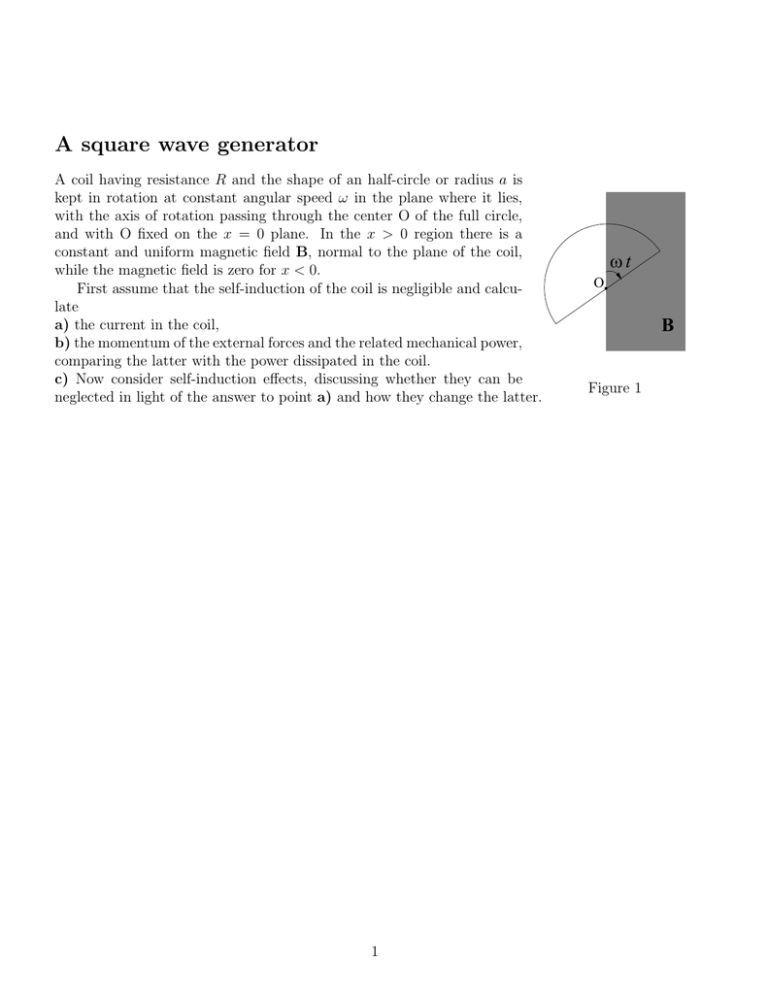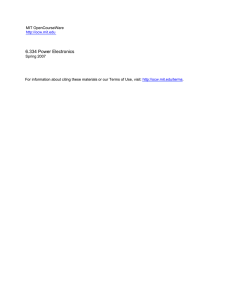A square wave generator
advertisement

A square wave generator A coil having resistance R and the shape of an half-circle or radius a is kept in rotation at constant angular speed ω in the plane where it lies, with the axis of rotation passing through the center O of the full circle, and with O fixed on the x = 0 plane. In the x > 0 region there is a constant and uniform magnetic field B, normal to the plane of the coil, while the magnetic field is zero for x < 0. First assume that the self-induction of the coil is negligible and calculate a) the current in the coil, b) the momentum of the external forces and the related mechanical power, comparing the latter with the power dissipated in the coil. c) Now consider self-induction effects, discussing whether they can be neglected in light of the answer to point a) and how they change the latter. 1 ωt O B Figure 1 Solution a) With reference to the figure 1), if ωt < π (modulus 2π), the area of the region in which the coil overlaps with the magnetic field increases with time and is given by S = ωta2 /2. If ωt > π, then S = (π − ωt)a2 /2, i.e. it decreases with t. Hence the sign of the derivative of the flux of the magnetic field Φ = BS changes when ωt = 0 or ωt = π (still, modulus 2π). The induced voltage is then E =− dΦ ωBa2 =− sign(π − ωt) , dt 2 (1) being sign(x) = x/|x|. Thus, E = E(t) and the current I = I(t) = E/R have the temporal profile of a square wave signal (figure 2) with period T = 2π/ω and amplitude E0 = RI0 = ωBa2 /2. I I0 T t −I 0 Figure 2 b) In order for the angular velocity to be constant, the momentum of the external forces must balance the momentum of the magnetic forces which act on the coil when the current flows. To find the momentum of magnetic forces we use Biot-Savart’s law. Along the semi-circumference the force df = Idl × B is in radial direction and does not contribute to the momentum. Thus it is sufficient to evaluate the contribution of the forces on the straight part of the coil, i.e. along the radius: Z Z Z a B 2 a4 a2 . (2) M = −Mext = r × df = Ir × (dr × B) = ẑ IBrdr = ẑIB = ω 2 4R 0 The mechanical power is Pext = Mext · ω = −Pd , (3) where Pd = RI 2 is the dissipated power. The power is constant in time (if neglecting the “abrupt” transient phase in which I changes sign and thus must go through a zero value). c) Including self-induction, the equation for the current in the coil is E(t) − L dI = RI , dt 2 (4) with E(t) as above. Thus, even if L is “small”, the contribution is not negligible because dI/dt would become infinite when the current changes its sign, as shown in figure 1. For a constant E, (4) has a solution E −Rt/L E I(t) = + I(0) − e . (5) R R We assume that I = I(0) = E0 /R at t = 0, with E0 = ωBa2 2, and that E( t) changes from E0 to −E0 at t = 0+ . Thus, by substituion in ( 5) we obtain I(t) = I0 (2e−Rt/L − 1) . (6) We thus see that due to self-induction the current does not change sign abruptly but following an exponential law with characteristic time τ = L/R. The solution described by (5–6) and shown in figure 3 is valid when τ ≪ T . If τ ≈ T instead, the current never reaches the maximum value I0 and the square wave signal is “distorted” as a series of exponential rises and decays. I I0 T t −I0 Figure 3 3



